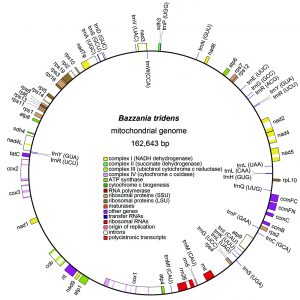 Dong S., Q. He, S. Zhang, H. Wu, B. Goffinet& Y. Liu. 2019. The mitochondrial genomes of Bazzania tridens and Riccardia planiflora further confirms conservative evolution of mitogenomes in liverworts. The Bryologist 122: 130–139.
Dong S., Q. He, S. Zhang, H. Wu, B. Goffinet& Y. Liu. 2019. The mitochondrial genomes of Bazzania tridens and Riccardia planiflora further confirms conservative evolution of mitogenomes in liverworts. The Bryologist 122: 130–139.
Abstract reads: The mitochondrial genomes of vascular plants are highly liable in both gene content and genome structure. In contrast, those of hornworts, liverworts, and mosses appear relatively stable over millions of years of evolution. All sequenced liverwort mitogenomes possess similar gene content and exactly the same gene order, except for that of Gymnomitrion concinnatum (Gymnomitriaceae, Jungermanniales), which is characterized by two rearrangements. To further explore the structural characteristic of liverworts mitogenomes, we sequenced and assembled the mitogenomes of representatives of two additional genera of liverworts, namely Bazzania tridens (Lepidoziaceae, Jungermanniales) and Riccardia planiflora (Metzgeriaceae, Metzgeriales). The two mitogenomes comprise 162,643 and 149,371 base pairs, respectively, and encoded the set of 72 genes present in all other liverwort mitochondrial genomes. The mitogenome of Bazzania tridens contains seven fewer introns than that of Marchantia, and the simple thalloid Riccardia planiflora contains one additional intron. A total of 370 and 471 C to U RNA editing sites were predicted from the 42 mitochondrial protein-coding genes of B.tridens and R.planiflora, respectively. The phylogenetic placement of the two taxa based on the mitochondrial protein-coding genes of thirteen liverwort species is consistent with former studies. Although the two sampled taxa are only distantly related, their mitogenomes share a same gene order, which is, moreover, shared by the majority of liverworts, thereby strengthening the hypothesis of overall stasis of the liverwort mitogenomes.